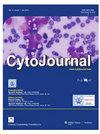结核性淋巴结炎确诊病例的细胞形态学发现
IF 2.5
4区 医学
Q2 PATHOLOGY
引用次数: 0
摘要
结核病(TB)仍然是一个重大的健康问题,尤其是在发展中国家。细针穿刺细胞学检查是结核性淋巴结炎的一线检查方法,因为它操作简便、创伤小、快速且经济。结核性淋巴结炎的典型细胞病理学特征包括上皮样细胞肉芽肿、兰汉斯巨细胞和酪质坏死。本研究旨在评估经 GeneXpert 确诊的结核性淋巴结炎新诊断病例的细胞形态学特征。本研究是一项回顾性研究,将 2022 年 7 月至 2023 年 7 月的一年内经 GeneXpert 确诊的结核性淋巴结炎新诊断病例的所有细针穿刺术纳入研究。这些抽吸物的 May-Grunwald-Giemsa 染色涂片被分为三种模式--有坏死的上皮样细胞肉芽肿、无坏死的上皮样肉芽肿和仅有坏死的上皮样细胞肉芽肿。肉芽肿又分为形态良好、形态不佳和分裂。在三种细胞形态学模式中,有坏死的上皮样肉芽肿占多数(67.5%),其次是仅有坏死的肉芽肿(20.8%)和无坏死的肉芽肿(11.6%)。齐氏-奈尔森染色法显示,53.3%的病例(64 例)呈耐酸杆菌(AFB)阳性。55例(57.9%)、42例(44.2%)和21例(22.1%)病例的肉芽肿构成良好、形成不良和分裂。中性粒细胞是最常见的背景细胞群(42,35%),其次是淋巴细胞(36,30%)。反应性淋巴细胞和嗜酸性粒细胞分别见于 12 个病例(10%)和 3 个病例(2.5%)。细针穿刺细胞学检查是一种快速、廉价的结核性淋巴结炎微创检查方法,因为上皮样细胞肉芽肿和病理坏死高度提示结核病。然而,手工检测耐酸性 AFB 的灵敏度较低,本研究中只有 53.3% 的病例显示出耐酸性 AFB。本文章由计算机程序翻译,如有差异,请以英文原文为准。
Cytomorphological findings in confirmed cases of tubercular lymphadenitis
Tuberculosis (TB) remains a major health problem, especially in the developing countries. Fine-needle aspiration cytology is the first line of investigation for tubercular lymphadenitis as it is easy to perform, less invasive, quick, and economical. The typical cytopathological features of tuberculosis TB include epithelioid cell granulomas with Langhans giant cells and caseous necrosis. The present study aimed to evaluate the cytomorphological features of newly diagnosed cases of tubercular lymphadenitis confirmed by GeneXpert.
This was a retrospective study in which all fine-needle aspirates from newly diagnosed cases of tubercular lymphadenitis confirmed by GeneXpert over a 1-year period from July 2022 to July 2023 were included in the study. The May–Grunwald–Giemsa stained smears from these aspirates were categorized into three patterns-epithelioid cell granulomas with necrosis, epithelioid granulomas without necrosis, and necrosis only. The granulomas were further categorized into well-formed, ill--formed, and splintered. The background of the aspirate which included a reactive lymphoid background, lymphocytes, eosinophils, and neutrophils was tabulated for all the cases.
Out of the three cytomorphological patterns, epithelioid granulomas with necrosis were the most predominant (67.5%), followed by necrosis only (20.8%) and granulomas without necrosis (11.6%). An acid-fast bacilli (AFB) positivity of 53.3% (64 cases) was seen on the Ziehl-Neelsen stain. Well-composed, poorly formed, and splintered granulomas were seen in 55 (57.9%), 42 (44.2%), and 21 (22.1%) cases, respectively. Neutrophils were the most common background population (42, 35%) followed by lymphocytes (36, 30%). Reactive lymphoid cells and eosinophils were seen in 12 (10%) and 3 (2.5%) cases, respectively.
Fine-needle aspiration cytology is a rapid inexpensive minimally invasive test for tubercular lymphadenitis as epithelioid cell granulomas along with caseous necrosis are highly suggestive of TB. However, manual acid-fast AFB detection has a low sensitivity as is illustrated in the present study where only AFBwas demonstrated in only 53.3% of cases.
求助全文
通过发布文献求助,成功后即可免费获取论文全文。
去求助
来源期刊

Cytojournal
PATHOLOGY-
CiteScore
2.20
自引率
42.10%
发文量
56
审稿时长
>12 weeks
期刊介绍:
The CytoJournal is an open-access peer-reviewed journal committed to publishing high-quality articles in the field of Diagnostic Cytopathology including Molecular aspects. The journal is owned by the Cytopathology Foundation and published by the Scientific Scholar.
 求助内容:
求助内容: 应助结果提醒方式:
应助结果提醒方式:


